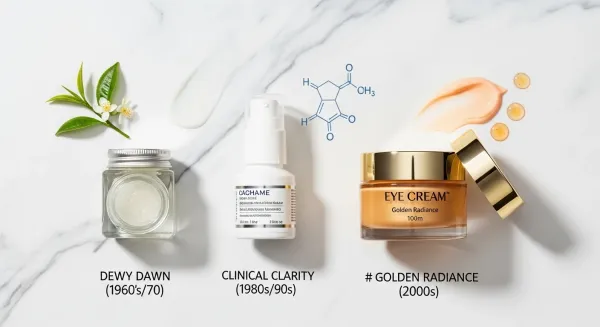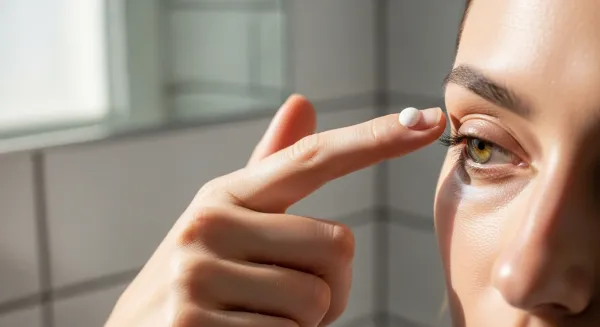The Ultimate Beginner’s Skincare Routine for Teens
Struggling with teenage skin? This guide provides a simple, effective beginner’s skincare routine for teens to achieve clear, healthy skin.

Want clear skin?
You’ve come to the right place. Let’s talk about a beginner’s skincare routine for teens. Teenage skin can be a rollercoaster – oily one minute, dry the next, and sometimes breaking out for no reason.
A good skincare routine can help you navigate these changes and build a foundation for healthy skin for years to come.
Key Takeaways: Beginner’s Skincare Routine for Teens
- Simplicity is key: A beginner’s skincare routine for teens doesn't need to be complicated. A few essential products are all you need.
- Consistency is king: Doing your routine regularly, even when you're tired or busy, is the most important factor for success.
- Sun protection is non-negotiable: Sunscreen isn't just for summer. It's your best defense against premature aging and skin damage.
- Listen to your skin: Pay attention to how your skin reacts to products and adjust your routine accordingly.
- Less is more: Don't overload your skin with too many products. Start simple and add more only if needed.
Understanding Your Skin Type
Before diving into a beginner’s skincare routine for teens, it’s important to know your skin type. This will help you choose the right products.

Mismatched products can exacerbate skin issues, leading to more breakouts, dryness, or irritation. Take the time to analyze your skin in the mirror, and even consider consulting a dermatologist for a professional assessment.
- Oily Skin: Your skin feels greasy and looks shiny, especially in the T-zone (forehead, nose, and chin). You're prone to breakouts. This is due to overactive sebaceous glands producing excess oil. Look for oil-free or non-comedogenic products that won't clog pores.
- Dry Skin: Your skin feels tight and flaky. It can be itchy and sensitive. This often results from a lack of moisture and oil production. Hydrating ingredients like hyaluronic acid and ceramides are your best friends.
- Combination Skin: You have a mix of oily and dry areas. Usually, the T-zone is oily, while the cheeks are dry. This requires a balanced approach, using different products for different areas of your face.
- Sensitive Skin: Your skin reacts easily to products, often becoming red, itchy, or irritated. Patch testing new products is crucial. Look for fragrance-free and hypoallergenic formulas.
- Normal Skin: Your skin is balanced, not too oily or dry. It's generally clear and not sensitive. Maintaining this balance is key. A simple routine with gentle products is usually all you need.
| Skin Type | Characteristics | Recommended Ingredients |
|---|---|---|
| Oily | Shiny, greasy, prone to breakouts | Salicylic acid, Benzoyl peroxide, Niacinamide |
| Dry | Tight, flaky, itchy, sensitive | Hyaluronic acid, Ceramides, Glycerin |
| Combination | Oily T-zone, dry cheeks | Balance of oil-control and hydration |
| Sensitive | Reacts easily to products, redness, irritation | Fragrance-free, Hypoallergenic |
| Normal | Balanced, clear, not sensitive | Gentle, maintaining balance |
Building Your Beginner’s Skincare Routine for Teens: The Morning
Your morning routine sets the stage for healthy skin all day. Think of it as prepping your skin for the day ahead, protecting it from environmental stressors like pollution and UV rays.
- Cleanse: Wash your face with a gentle cleanser to remove dirt and oil that has accumulated overnight. If you have oily or acne-prone skin, look for a cleanser with salicylic acid or benzoyl peroxide. These ingredients help to unclog pores and prevent breakouts. For dry or sensitive skin, a creamy, hydrating cleanser is best, avoiding harsh foaming agents. I’ve seen great results with Cetaphil Gentle Skin Cleanser for sensitive skin types. Lukewarm water is ideal, as hot water can strip your skin of its natural oils.
- Tone (Optional): A toner can help balance your skin's pH and prep it for the next steps in your routine. Choose an alcohol-free formula to avoid drying out your skin. Look for ingredients like witch hazel or rosewater for their soothing and balancing properties.
- Treat: If you have specific skin concerns like acne or dark spots, apply a targeted serum. Vitamin C serums are great for brightening and protecting against free radical damage, while niacinamide can help with inflammation and redness. Apply a small amount to your fingertips and gently pat into your skin.
- Moisturize: Even oily skin needs moisturizer! A moisturizer helps to hydrate and protect your skin, creating a barrier against environmental aggressors. Choose a lightweight, non-comedogenic formula for oily skin. Dry skin types can benefit from richer creams with hydrating ingredients. A good moisturizer creates a barrier, protecting your skin from environmental aggressors.
- Sun Protection: This is the most important step! Apply a broad-spectrum sunscreen with at least SPF 30 every single day, even on cloudy days. UV rays can penetrate clouds and cause damage, leading to premature aging and skin cancer. L'Oréal Paris Bright Reveal Broad Spectrum SPF 50 is a solid choice. Reapply every two hours, especially after swimming or sweating.
| Morning Routine Step | Product Type | Skin Type Benefit |
|---|---|---|
| Cleanse | Gentle cleanser | Removes dirt and oil |
| Tone | Alcohol-free toner | Balances pH, preps skin |
| Treat | Serum (Vitamin C, Niacinamide) | Targets specific concerns |
| Moisturize | Lightweight (oily), Rich (dry) | Hydrates, protects |
| Sun Protection | Broad-spectrum SPF 30+ | Prevents sun damage |
Building Your Beginner’s Skincare Routine for Teens: The Evening
Your evening routine is all about cleaning and repairing. It's a chance to remove all the day's grime and allow your skin to rejuvenate overnight.
- Double Cleanse: If you wear makeup, start with a makeup remover, like micellar water or an oil-based cleanser, to break down makeup and sunscreen. Then, wash your face with your regular cleanser to remove any remaining traces of makeup, sunscreen, and dirt. This ensures a clean slate for your skin to repair overnight. This two-step process ensures a thorough cleanse.
- Treat: Apply any spot treatments or serums. Retinoids can be helpful for acne by increasing cell turnover and preventing clogged pores, but start slowly and use them only at night. They can make your skin more sensitive to the sun. Other treatments, like those containing AHAs or BHAs, can also be incorporated a few times a week to address specific concerns.
- Moisturize: Use the same moisturizer as in the morning, or you can opt for a slightly richer formula at night. Nighttime is when your skin repairs itself, so a good moisturizer can help support this process by providing hydration and locking in moisture.
| Evening Routine Step | Product Type | Benefit |
|---|---|---|
| Double Cleanse | Makeup remover, Cleanser | Thoroughly removes makeup and impurities |
| Treat | Spot treatment, Serum | Addresses specific concerns |
| Moisturize | Moisturizer | Hydrates and supports overnight repair |
Weekly Boosters for Your Beginner’s Skincare Routine for Teens
These extra steps can take your skincare game to the next level. Think of these as treatments to give your skin an extra boost.
- Exfoliate: Once or twice a week, use a gentle chemical exfoliant to remove dead skin cells. This can help prevent breakouts and improve skin texture. Chemical exfoliants, like those containing AHAs (alpha-hydroxy acids) or BHAs (beta-hydroxy acids), work by dissolving the bonds between dead skin cells, allowing them to be gently sloughed away. Avoid harsh scrubs, which can irritate your skin and cause microtears. Check out our guide on essential exfoliation tips for darker skin for more information. Start slowly and gradually increase the frequency as tolerated.
- Face Mask: A weekly face mask can provide extra hydration or address specific skin concerns. Clay masks are great for oily skin, drawing out impurities and absorbing excess oil. Hydrating masks are beneficial for dry skin, replenishing moisture and leaving skin feeling soft and supple. Sheet masks are a fun and convenient option.
| Weekly Booster | Benefit | Frequency |
|---|---|---|
| Exfoliate | Removes dead skin cells, improves texture | 1-2 times/week |
| Face Mask | Addresses specific concerns, extra hydration | 1-2 times/week |
Key Ingredients to Look For
Here’s a quick rundown of some helpful ingredients: Understanding the function of key ingredients can help you make informed choices about the products you use.
| Ingredient | Benefit | Skin Type |
|---|---|---|
| Salicylic Acid | Exfoliates pores, fights acne | Oily, Acne-Prone |
| Benzoyl Peroxide | Kills acne-causing bacteria | Oily, Acne-Prone |
| Niacinamide | Reduces redness, controls oil | All Skin Types |
| Hyaluronic Acid | Hydrates skin | Dry, All Types |
| Vitamin C | Brightens skin, antioxidant protection | All Skin Types |
| Ingredient | Function |
|---|---|
| Ceramides | Strengthen skin barrier, retain moisture |
| Retinoids | Increase cell turnover, treat acne |
| AHAs (Glycolic, Lactic) | Exfoliate, brighten, improve texture |
| BHAs (Salicylic) | Exfoliate pores, reduce acne |
| Green Tea | Antioxidant, anti-inflammatory |
My Personal Skincare Journey
When I was a teenager, I struggled with acne. I tried everything – harsh scrubs, tons of different products, and even toothpaste (don’t do that!). It wasn't until I simplified my routine and focused on gentle, consistent care that my skin started to clear up.
One key change was switching to a cleanser with salicylic acid, which made a huge difference. I also learned the importance of not picking at my skin and being patient with the process. It took time, but my skin eventually cleared up, and I developed a healthy skincare routine that I still follow today.
Common Mistakes to Avoid
- Over-cleansing: Washing your face too often can strip your skin of its natural oils, disrupting its protective barrier and leading to dryness, irritation, and even increased oil production as your skin tries to compensate. Stick to cleansing twice a day, morning and night.
- Picking at pimples: This can cause scarring, spread bacteria, and worsen inflammation. Resist the urge! Try using spot treatments instead.
- Using harsh products: Strong ingredients like alcohol and harsh scrubs can irritate teenage skin, which is often more sensitive. Opt for gentle, fragrance-free formulas.
- Not wearing sunscreen: This is the biggest mistake you can make! Sun damage accumulates over time, leading to premature aging, wrinkles, dark spots, and increasing your risk of skin cancer. Make sunscreen a non-negotiable part of your daily routine.
- Ignoring your skin type: Using products that aren't suited for your skin type can exacerbate existing issues. Understand your skin type and choose products accordingly.
| Mistake | Consequence |
|---|---|
| Over-cleansing | Dryness, irritation, increased oil production |
| Picking at pimples | Scarring, infection, inflammation |
| Harsh products | Irritation, sensitivity |
| No sunscreen | Premature aging, sun damage, skin cancer risk |
| Ignoring skin type | Worsening of existing skin issues |
Expert Advice for a Beginner’s Skincare Routine for Teens
As a skincare expert, I've seen firsthand how a simple, consistent beginner’s skincare routine for teens can transform skin. Don't get caught up in the hype of complicated routines or expensive products. Focus on the basics: cleansing, moisturizing, and sun protection.
If you have specific skin concerns, like acne, add targeted treatments. And remember, be patient! It takes time to see results. It's not an overnight fix, but with consistent care, you'll see improvements.
If you're struggling with persistent skin issues, consider consulting a dermatologist. They can provide personalized advice and treatment options. For more information on how to treat dark spots, check out our article on how to treat dark spots on darker skin.
Skincare and Self-Care: A Holistic Approach
A beginner's skincare routine for teens is more than just about clear skin. It's about self-care.
Taking a few minutes each day to care for your skin can boost your confidence and help you feel good about yourself. It's a form of self-love and a way to prioritize your well-being.
Remember, healthy skin is beautiful skin. For those with sensitive skin, our skincare routine for sensitive skin offers valuable insights.
Hydration Heroes: The Importance of Water
While topical products play a crucial role, internal hydration is equally vital. Drinking plenty of water throughout the day helps flush out toxins, keeping your skin hydrated and plump.
This contributes to a healthier complexion overall. Water helps to maintain the skin's elasticity and prevents it from looking dull and dehydrated. Carry a reusable water bottle with you and aim for at least 8 glasses a day.
Nutrition's Impact on Skin Health
A balanced diet rich in fruits, vegetables, and whole grains provides essential nutrients for skin health. Foods high in antioxidants, like berries and leafy greens, can protect against free radical damage, which can contribute to premature aging.
While healthy fats, found in avocados and nuts, support skin cell regeneration and maintain its elasticity. Limit processed foods, sugary drinks, and excessive dairy, as these can trigger breakouts and inflammation.
| Food Group | Benefit for Skin |
|---|---|
| Fruits & Vegetables | Antioxidants, Vitamins, Hydration |
| Whole Grains | Fiber, regulates blood sugar |
| Healthy Fats | Cell regeneration, elasticity |
| Lean Protein | Collagen production, cell repair |
The Power of Sleep for Skin Rejuvenation
Getting enough sleep is crucial for skin repair and renewal. During sleep, your body produces collagen, a protein that keeps skin firm and youthful.
Lack of sleep can lead to dark circles, puffiness, and a dull complexion.
Aim for 8-10 hours of quality sleep each night to allow your skin to rejuvenate and maintain its healthy glow. Establish a regular sleep schedule and create a relaxing bedtime routine to promote better sleep.
| Sleep Benefit | Impact on Skin |
|---|---|
| Collagen Production | Maintains firmness and elasticity |
| Cell Renewal | Repairs and rejuvenates skin |
| Reduced Inflammation | Prevents breakouts and redness |
| Improved Circulation | Delivers nutrients and oxygen to skin cells |
Conclusion
A beginner's skincare routine for teens should be simple, effective, and tailored to your individual needs. By following the tips and guidelines outlined in this article, you can establish a solid foundation for healthy, radiant skin.
Remember, consistency is key, and listening to your skin's unique needs will guide you towards the perfect regimen. Don't hesitate to consult a dermatologist if you have persistent skin concerns or require personalized advice.
Further Resources:
Frequently Asked Questions (FAQs)
How often should I wash my face?
Twice a day, morning and night, is usually sufficient. Wash your face daily and after exercise. Because regular bar soap often contains harsh ingredients that can be drying to the skin, wash your face with a mild facial cleanser and lukewarm — not hot — water. Avoid harsh cleansers and over-exfoliation. It's best to wash your face twice a day with a gentle, oil-free cleanser. Over-cleansing can actually lead to increased oil production.
What if my skin gets worse when I start a new routine?
This is sometimes called "purging," and it can happen when your skin adjusts to new products. If it persists for more than a few weeks, consult a dermatologist. It can take several weeks to months to see significant improvement. Consistency is crucial, and patience is key. Changes vary for everyone. Your skin cells renew constantly. You might see small improvements in a few weeks. Think less redness or more hydration. Full, noticeable benefits often take 1-3 months. Stick with it. Consistency is the real secret. Your skin needs time to respond. Like any wellness journey, patience and persistence are key to achieving lasting results. Don't expect immediate results.
Do I need to use a toner?
It's optional. If you find it helpful, use it. If not, you can skip it. An effective routine for teenagers includes four core steps: 1. Cleansing with a gentle cleanser, 2. Toning to balance pH levels, 3. Moisturizing to hydrate and protect the skin, and 4. Applying SPF 30 sunscreen daily for sun protection. Adding serums or spot treatments can further enhance results based on specific needs. It's best to start with thin, water-based products like toners and ampoules, followed by thicker ones like moisturizers and oils.
What's the best way to treat acne?
Start with a simple routine that includes a cleanser with salicylic acid or benzoyl peroxide. If that doesn't work, consult a dermatologist. The best spot treatments for teenage acne often contain salicylic acid, benzoyl peroxide, sulfur, or retinoids. The right choice depends on the type of acne you're dealing with. A consistent skincare routine with a gentle cleanser, targeted treatments (like retinoids or benzoyl peroxide), and a lightweight moisturizer is key. Do this twice daily. If your acne is severe, persistent, or not improving with over-the-counter treatments, it's time to consult a dermatologist for personalized recommendations.
How long does it take to see results?
Be patient! It can take several weeks or even months to see significant changes in your skin. It can take several weeks to months to see significant improvement. Consistency is crucial, and patience is key. Changes vary for everyone. Your skin cells renew constantly. You might see small improvements in a few weeks. Think less redness or more hydration. Full, noticeable benefits often take 1-3 months. Stick with it. Consistency is the real secret. Your skin needs time to respond. Like any wellness journey, patience and persistence are key to achieving lasting results. Don't expect immediate results. New skincare regimens can take 6-12 weeks to show noticeable effects.




